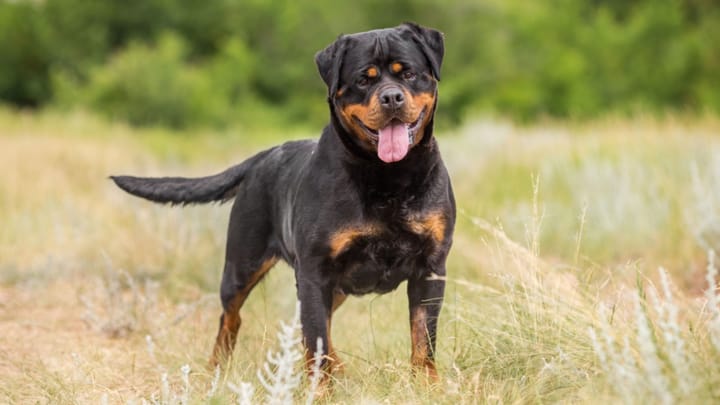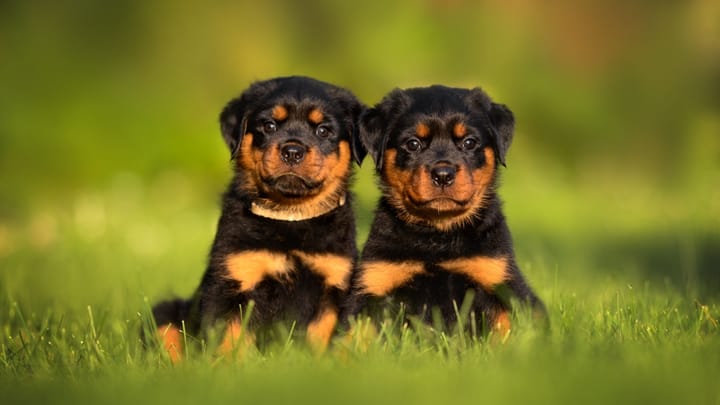Rottweiler
Other names : German mountain dog, Rottweiler Metzgerhund, Rott, Rottie


The Rottweiler is a robust, powerful, and courageous dog with a calm, loyal nature. Deeply devoted to their social group, they are protective and naturally wary of strangers, but affectionate and gentle once trust is gained. Despite an undeserved reputation for aggression, early, consistent training is essential. As a second-category breed, they are subject to strict UK regulations.
|
Life expectancy |
The Rottweiler has a life expectancy of between 8 and 10 years |
|
Temperament |
|
|
Size |
Large
|
|
Adult size |
Female
Between 22 and 25 in
Male
Between 24 and 27 in
|
|
Adult weight |
Female
Between 93 and 110 lb
Male
Between 99 and 119 lb
|
|
Coat colour
The coat is black with some patches of tan (brown-red) on the cheeks, snout, eyes, chest, limbs, and at the base of the tail. |
Black |
|
Type of coat
The fur is mid-length but shorter in some areas. The outer coat is tight, hard to the touch, compact, and smooth. The undercoat is soft and should not be exposed. |
Hard |
|
Eye colour
The eyes are dark brown. |
Brown
|
|
Purchase price |
The Rottweiler costs between £600 and £920 |
This breed is regulated, in some places, by law. Owners who want to adopt a dog like this must respect several things:
- Get a holding permit with a qualified canine educator
- Register the dog
- Get him a rabies vaccination
- Take out liability insurance
- Perform a behavioural evaluation of the dog with a veterinarian when he is between 8 to 12 months of age
- Don’t leave him alone with children, or allow minors to walk him alone
- Keep abreast of local dog-related bylaws
- Keep the dog on a lead and wearing a muzzle
It is not uncommon to see the term "Royal Rottweiler". However, no difference is officially recognised between the different sizes; therefore, the Royal Rottweiler does not exist. This term is often used by unscrupulous breeders to add value to their dogs.
It is the same for the white Rottweiler which is often considered rare. Otherwise known as the Snow Rott, you should know that Rottweilers with a white mark on their chest are certainly rare, but it is a defect that invalidates the official standard. The same goes for Rottweilers who have long fur coat.
Therefore, you must be careful when adopting a Rottweiler. You need to avoid falling into the “rare dog trap”. All dogs of this breed are pretty much the same. There is just one official category of Rotts, so nothing justifies an increase in the selling price.
The Rottweiler is a common parent in mixed-breeds. Discover 10 of the most popular Rottweiler crossbreeds.
More details about the Rottweiler
Rottweiler: Origins and history
His ancient origin is common to that of all the molossoid-types which have, as their ancestor, the Tibetan Mastiff. Dogs of the molossoid type were present in Germany under different names that varied according to the region. His name comes from the town of Rottweil, where the former “butchers' dog” was common. He helped, accompanied, and protected butchers and their animals. At the beginning of the 20th century, the use of a Rottweiler to drive and watch animals was prohibited. However, he is extremely versatile and is employed to stand guard, defend his master, and perform other activities such as dog-sledding. During the First World War, he was used by law enforcement for his many skills, and he became very popular internationally.
Physical characteristics of the Rottweiler
This dog breed is robust, of medium to large size, and has a massive, muscular body that is capable of incredible strength, flexibility, and endurance. The jaw is very strong and powerful, so owners need to stay vigilant.
FCI classification of the Rottweiler
-
Group 2 - Pinscher and Schnauzer - Molossoid and Swiss Mountain and Cattledogs
-
Section 2 : Molossian type
Rottweiler: Characteristics
Rottweiler: Behaviour
Training a Rottweiler
The Rott has a rather strong character and it is not easy to educate him despite his intelligence and docility. Early education is needed and educational methods must be consistent and firm without the use of violence.
This dog is not to be entrusted to people outside his social group because he could quickly get out of control if he hasn’t been properly educated.
Moreover, this breed requires safe and substantial teaching to discourage the further spread of that bad reputation of which he is a victim.
Try to teach him to wear a muzzle and walk on a lead without pulling. This way you guarantee that walks are safe, respectful of the law, and serene for both the dog and his owner.
Moreover, a rich lesson in socialisation is needed so that the Rottweiler puppy can behave as required throughout adulthood.
It should be noted that the female Rottweiler is more docile than the male and accepts the authority of her master more easily. However, this will vary depending on her character, education, and relationship with her social group.
Rottweiler: Lifestyle
Breed compatibility Rottweiler
Rottweiler: Purchase price
The price of a Rottweiler varies according to his origins, age and gender. They cost on average £920 when registered with the Kennel Club.
A monthly budget of £60 is necessary to offer this dog a quality diet and all the veterinary care that he needs.
A Rottweiler’s budget should also allow for additional vaccinations, one or more behavioural evaluations, and subscription to an insurance policy.
Rottweiler: Health
The Rottweiler lives for about 9 years.
He is particularly robust, enduring and strong. He is rarely ill.
The Rottie is not good at tolerating heat and will need to remain cool, so he should avoid intense physical stimulation when temperatures are rising.
Provide fresh water and renew it regularly.
This big chap is very resistant to bad weather thanks to the tight fur and undercoat, which give him good protection against the cold.
This dog’s greed can sometimes play tricks on him, but a balanced diet and regular physical activity will allow him to keep his weight in check.
- Fragile growth; since they grow fast, it can lead to skeletal deformations
- Congenital heart diseases
- Ocular disorders (progressive atrophy of the retina, ectropion and entropion)
- Stomach dilation/torsion syndrome
- Bone cancer
- Lymphosarcoma (cancer of the lymphatic system)
- Hip and elbow dysplasia
Do you want a Rottweiler dog ?
Frequently asked questions
Is the Rottweiler a good family dog?
The Rottweiler is an excellent family dog because it is loyal, protective and affectionate. This breed is particularly gentle with children but do keep in mind that, with any dog, you should never leave a child alone with your dog without supervision.
Is a Rottweiler a good first dog?
The Rottweiler isn't the best breed for first time owners. However, as long as you are willing to learn everything about the breed and training is consistent then the Rottweiler could potentially be a good first dog for you.
Are Rottweilers hard to train?
The Rottweiler is very intelligent and has a strong personality, therefore it can be a little bit challenging to train. Now, with that being said, early training and sociabilisation will help your dog in his training sessions. Make sure you are consistent, use positive reinforcement, keep him entertained and never use violence.
What is the price of a Rottweiler?
The price of a Rottweiler will vary according to the origins, gender and age of this breed. If a dog is registered with the Kennel Club, the price will be on average £920. If the dog isn't registered with the Kennel Club, it will cost on average £600 to buy a Rottweiler.
How long do Rottweilers live for?
The lifespan of a Rottweiler is between 8 to 10 years.








